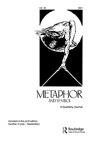Embodied Metaphor Processing: A Study of the Priming Impact of Congruent and Opposite Gestural Representations of Metaphor Schema on Metaphor Comprehension
IF 3.3
3区 文学
0 LANGUAGE & LINGUISTICS
引用次数: 6
Abstract
ABSTRACT This study examined the performances of three groups of participants in interpreting metaphors in three different conditions: congruent gesture-prime conditions, opposite gesture-prime conditions, and no-prime conditions. In congruent gesture-prime conditions, each metaphor was preceded by the congruent gestural representation of metaphor schema. In opposite gesture-prime conditions, each metaphor was preceded by the opposite gestural representation of metaphor schema. The results showed that participants of congruent gesture-prime conditions had the best performance in interpreting metaphors, while participants of opposite gesture-prime conditions had the worst performance. It is suggested that metaphor schema is an important part of metaphorical meaning of a metaphor. Therefore, when this part of meaning is activated by a gestural prime, metaphor comprehension is facilitated. Furthermore, when a schema is used to metaphorically describe a concept or an event, that schema and the neural network that represents it become one part of a larger interconnected neural network that represents the meaning of the metaphor. It could mean that the activation of one part of it could facilitate the activation of the whole of the network. Finally, it is emphasized that a gesture that depicts the schema of a metaphor is in fact the embodied realization of that metaphor.具身隐喻加工:隐喻图式的一致和相反的手势表征对隐喻理解的启动影响研究
摘要本研究考察了三组被试在三种不同条件下的隐喻解释表现:一致的手势启动条件、相反的手势启动条件和无启动条件。在相同的手势启动条件下,每个隐喻之前都有相同的隐喻图式手势表征。在相反的手势启动条件下,每个隐喻之前都有相反的隐喻图式的手势表征。结果表明,手势启动条件一致的被试在隐喻解释上表现最好,而手势启动条件相反的被试在隐喻解释上表现最差。认为隐喻图式是隐喻意义的重要组成部分。因此,当这部分意义被手势启动时,隐喻的理解就容易了。此外,当一个图式被用来隐喻性地描述一个概念或一个事件时,这个图式和代表它的神经网络就成为一个更大的相互连接的神经网络的一部分,这个神经网络代表了隐喻的意义。这可能意味着它的一部分的激活可以促进整个网络的激活。最后,强调了描绘隐喻图式的手势实际上是该隐喻的具体化实现。
本文章由计算机程序翻译,如有差异,请以英文原文为准。
求助全文
约1分钟内获得全文
求助全文
来源期刊

Metaphor and Symbol
Multiple-
CiteScore
2.90
自引率
0.00%
发文量
23
期刊介绍:
Metaphor and Symbol: A Quarterly Journal is an innovative, multidisciplinary journal dedicated to the study of metaphor and other figurative devices in language (e.g., metonymy, irony) and other expressive forms (e.g., gesture and bodily actions, artworks, music, multimodal media). The journal is interested in original, empirical, and theoretical research that incorporates psychological experimental studies, linguistic and corpus linguistic studies, cross-cultural/linguistic comparisons, computational modeling, philosophical analyzes, and literary/artistic interpretations. A common theme connecting published work in the journal is the examination of the interface of figurative language and expression with cognitive, bodily, and cultural experience; hence, the journal''s international editorial board is composed of scholars and experts in the fields of psychology, linguistics, philosophy, computer science, literature, and media studies.
 求助内容:
求助内容: 应助结果提醒方式:
应助结果提醒方式:


